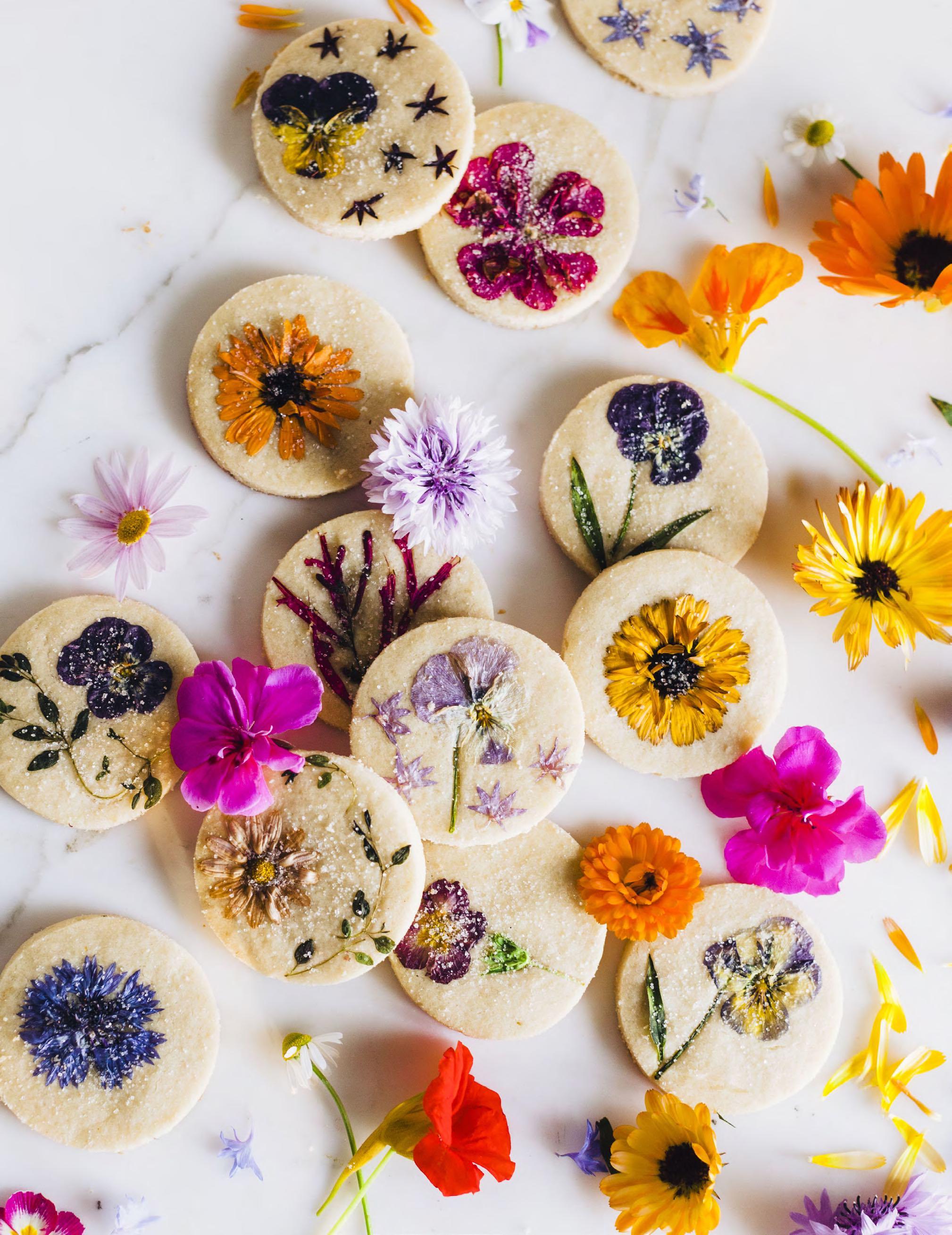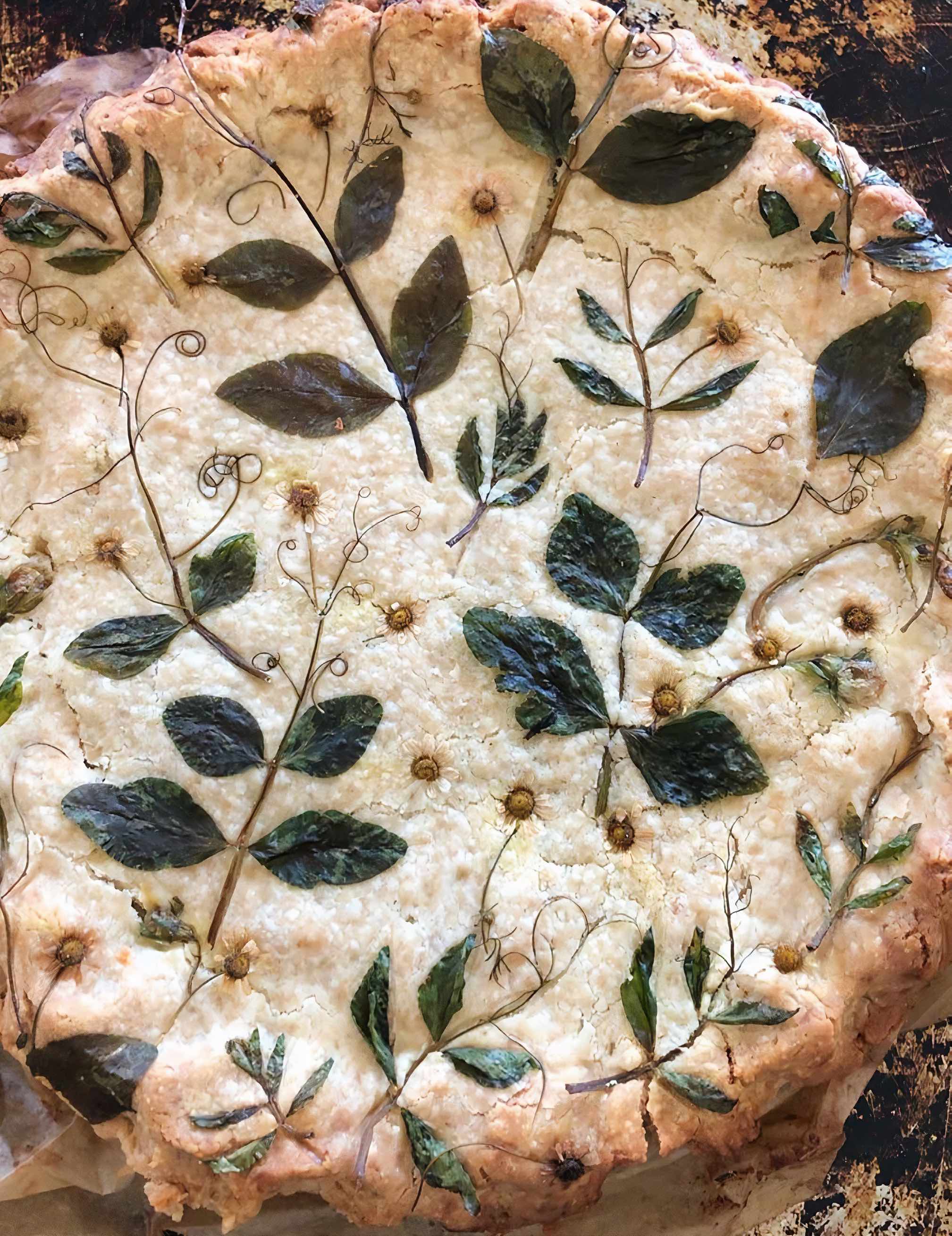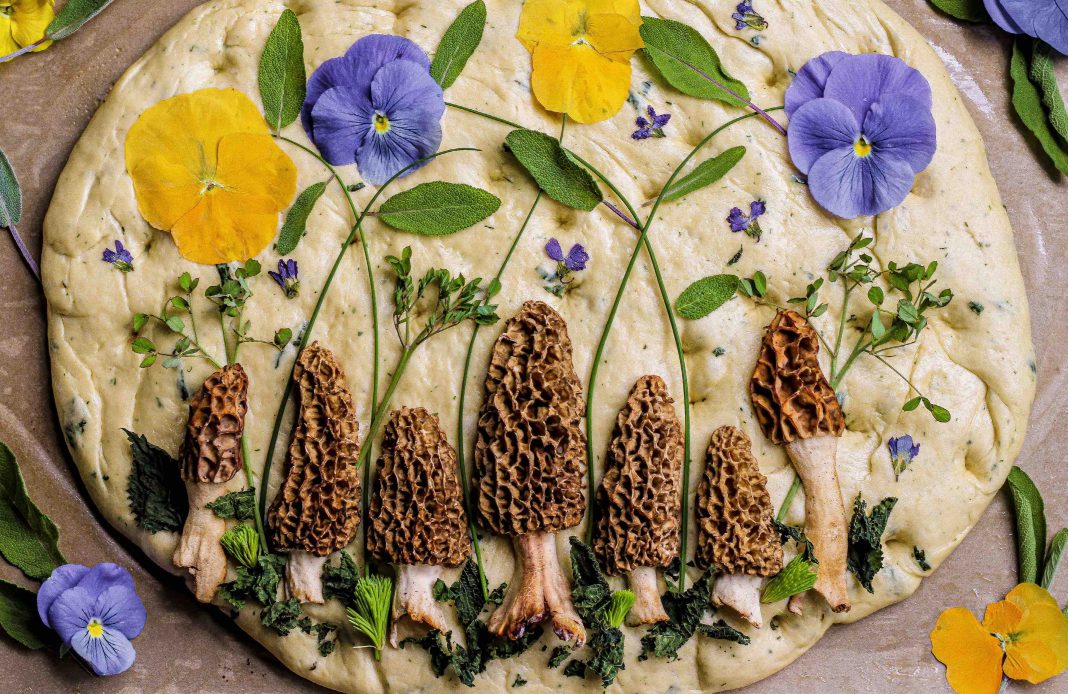When my family and I were captive in our New York City apartment during the Covid spring, our yearning for nature was palpable. Fortunately, we have big windows, lots of light, and a view of Central Park, but distance-sightings of flowers and greenery were somewhat less than satisfying.
As soon as the city opened up, we headed for the open road. Our thirty-hour road trip to Montana was an adventure. We arrived at a family cabin up in the mountains, and woke up the next morning surrounded by unimaginable beauty: fields of wildflowers; crisp, cool air; melted snow cascading down mountaintops into an alpine lake. My daughter and her fiancé took a twelve-hour hike in the mountains, and they brought back buckets filled with huckleberries and wild flowers. After dinner, we got out a flower press and began to press the beautiful flowers.
There are awakenings to be had as a result of these challenging times, and many of us are searching for silver linings right now. One I am reminded of as I gulp in deep breaths of fresh, clean mountain air is an appreciation of nature and the outdoors. A need to slow down and translate experience into creative outlets that challenge and comfort us, like baking, is another. Delicious, artfully decorated “food art” inspired by nature combines the two: It is no less than a defining moment right now.
Those pressed flowers reminded me of the work of three inventive artisanal bakers who create enchanting—and delicious—works of art in their kitchens by baking with flowers and herbs. When I heard about their lovely creations, I wanted to make them. Now I can, and their brilliant tips will inspire you to bake with herbs and flowers too!
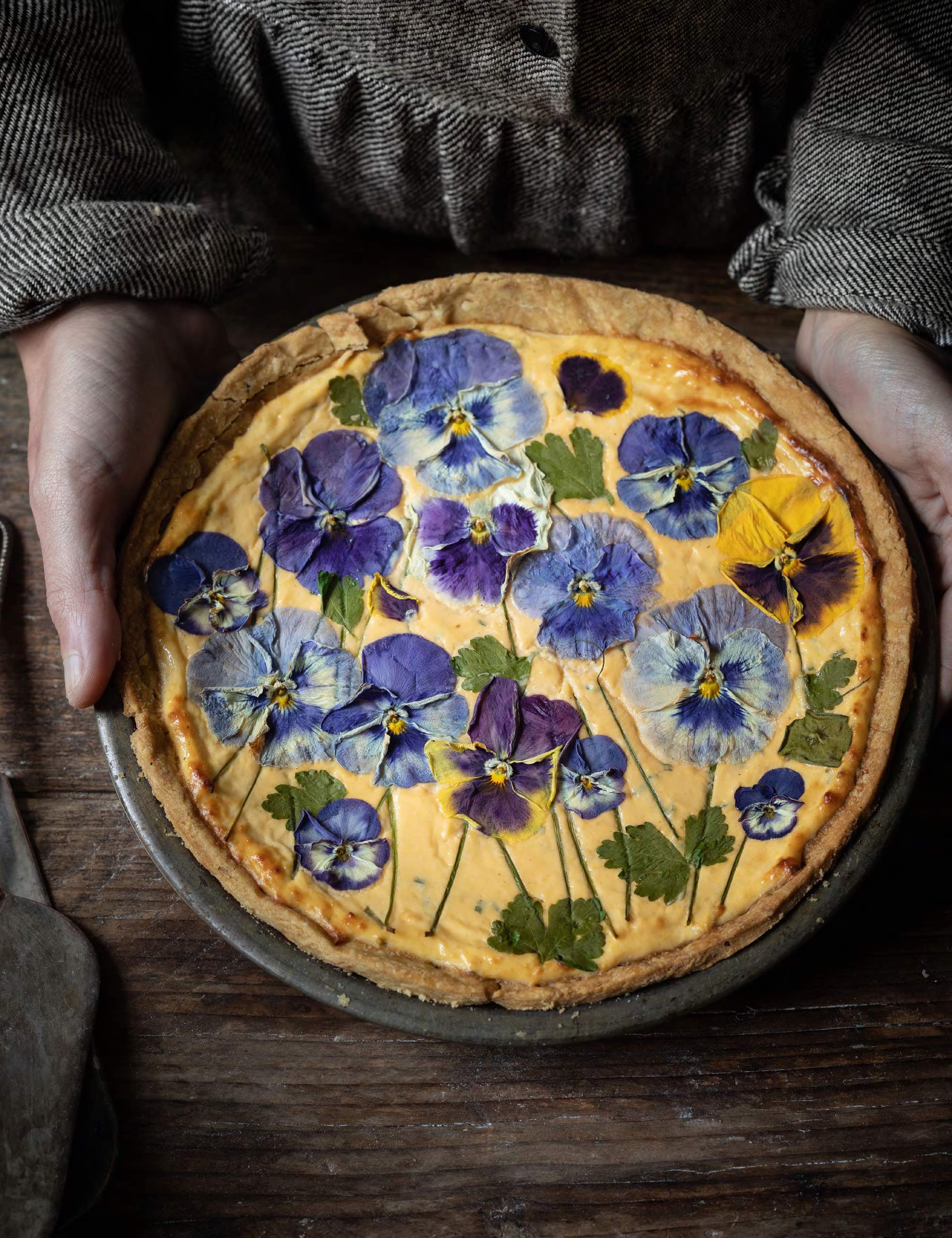
Aimee Twigger, Twigg Studios
A photographer, food stylist, blogger, and baker extraordinaire, Aimee Twigger, founder of Twigg Studios, was born in Torquay, a small seaside village in England. She shares recipes and offers workshops on her website twiggstudios.com, and two of her stunning creations—including her renowned ricotta and Parm cheesecake tart—are illustrated here.
Twigger bakes galettes, focaccia, and all sorts of sweets, beautifully decorated with flowers, herbs, and vegetables. “I love to make anything that involves dough, as I love to use my hands.” She grew up in an artistic family, and her father would encourage her and her brothers to draw and paint or build things in his workshop on weekends. “I loved to use clay and make sculptures or build things from paper,” she says.
“When I found my passion for baking, the two seemed to overlap and I enjoyed creating art with the things I baked, using pastry or fruit in the same way I would have used clay.”
She now lives by the coast in South Devon, where she is inspired by nature. “I love to see the seasons change, and the way the light shifts. We are lucky to have a lot of fields and moorland nearby. Going for walks always sparks an idea.” Twigger loves baking because it can be a great way to unwind and spend time with family.
The ricotta and Parm cheesecake tart is truly a work of art, which, Twigger says, was “amazingly easy, as I just had to place the flowers onto cheesecake and bake it. The oven was at quite a low temperature to bake the cheesecake filling, so luckily the flowers kept their color. The design was inspired by an old painting that I saw.
“Mother nature gives us the most beautiful things. I like to celebrate them,” she says. “I love how they are so different and imperfect but still perfect at the same time. I really love botanical flavors. I find that I am constantly amazed at how something so beautiful, like a flower, exists. Mother nature constantly surprises me. Being able to use nature’s own little works of art in the things I make feels quite magical and special.”
Top Tips from Twigg Studios
The flowers or herbs need to be organic and unsprayed with any chemicals or pesticides. Edible flowers cannot be washed, so they must be organic to be sure that they are free of chemicals or pesticides.
Some flowers have a lot of flavor and can enhance a recipe. Others have little flavor. They are edible but are there more for decoration. I would recommend learning about different edible flowers and their flavors. Some work better for savory recipes and some for sweet recipes.
Certain colored flowers keep their colors best in the heat of the oven. I have found that deep yellows and oranges and dark blues and purples seem to work best.
Some flowers can wilt quite quickly once placed on a cake, so I will wait until the last moment before adding them.
Make sure you are 100 percent sure that what you have picked is edible. Some flowers or parts of flowers are poisonous.
Lauren May, Must Love Herbs
Lauren May, founder of Must Love Herbs, is a forager, baker, gardener, and food photographer. She is also the creator of the gorgeous Forager’s Focaccia, pictured on page 22.
May’s country roots have left a deep imprint on her work. “Growing up in rural Appalachia, much of my knowledge of edible flowers, herbs, and foraging was passed down to me from my grandfather,” May says. “For me it is a passion, but for him and his family it was an integral part of life. Herbal medicine and ‘eating the weeds’ is something that, only a few generations ago, was part of everyday living. The knowledge is still there for those who want to learn from their elders.”
Inspired by nature, May grows or forages for plant ingredients in the nearby forest or her organic garden. If she doesn’t have enough of what she needs, she supplements from local farmers or markets. “Both foraging and gardening have always been completely intertwined in my baking. I often garden with my baking in mind.” In her garden this year, for example, she planted only beneficial flowers that could be used both in baking and as medicine. “Foraging has inspired me to embrace the wild in both my baking and my aesthetics. There truly isn’t anything more beautiful than nature. I try to incorporate it into everything I do.”
The Forager’s Focaccia was inspired by the forest surrounding May’s home, where there is an abundance of wild mushrooms, flowers, and herbs. “I love walking through the woods in the early morning when the sun is just beginning to rise and the forest floor is still dark. It is a truly magical experience. I set out to re-create that in a work of ‘food art.’”
Completely self-taught, May insists that it’s easier than it looks to create a breathtakingly beautiful focaccia like hers. “You just have to be willing to fail and keep learning from your mistakes. As long as you enjoy it and keep at it, then you are truly succeeding.” For the Forager’s Focaccia, she starts by making a rough version of what she wants the decorations to look like on a piece of parchment paper while the dough is proofing. Then she transfers them over to the dough and fills in any areas that look imbalanced. She also improvises and largely depends on what she has ready to be harvested. “I try to think out of the box by using things such as squash blossoms, pea shoots, and even bean flowers with more traditional herbs like basil or rosemary. I love that when I’m baking with herbs and flowers, I’m bringing nature in. Also, herbs and flowers often have great health benefits that you normally wouldn’t get. The nettle in my Forager’s Focaccia is considered to be a superfood. It makes you feel a little less guilty when you eat half of it!”
But baking is not only about literal nourishment. “Baking is soothing in these trying times,” she says. “It’s a way to work with your hands and see something come together before your eyes. When I’m baking, I forget everything that is going on around me, and all that matters is that cake, bread, or pie crust. It is a really nice reprieve from the information overload that we all experience in today’s society. I have always been a baker and found such comfort in it, but in this past year it has felt as much like therapy as a hobby.”
Must Love Herbs’ Top Tips
Don’t be afraid to experiment with what you have. As long as you know it is edible, use it!
Don’t eat flowers if you aren’t certain they are edible. There are many free resources online as well as in-depth books you can purchase that will help you with this.
Oil is often your best friend when it comes to preserving color and integrity while baking. I mist oil liberally over the herbs and flowers before baking. This keeps them from drying out or moving during baking.
Harvesting herbs and flowers in the morning will ensure that they are packed full of flavor as well as moisture content. This is key in having wilt-free specimens.
Don’t put yourself in a box thinking you can’t use flowers with vegetables or herbs. Experiment with combinations that aren’t tried and true—such as rosemary and nettle, hollyhocks and basil, or pansies and chives. Nature has an amazing way of coordinating even when you think it won’t.

Loria Stern, Loriastern.com
Loria Stern is a California-based chef and caterer who specializes in small-batch cookies and tarts decorated with hand-pressed seasonal plants. Two of her beautiful creations are pictured here, and she teaches online classes for those who want to attempt to master the craft. The inspiration came to her when a lightning bolt hit, and she figured out how to meld two of her passions into one.
“My interest in cooking with botanicals began in 2010, when I was working as a pastry chef at a fancy hotel while also taking an adult education class entitled Medicinal and Edible Plants,” she says. “Through this class I learned about many California native plants that are edible and were often used as medicine. This inspired me to start using these plants in the pastry techniques I was learning at work. Those two ideas came together and I haven’t stopped experimenting since.”
The inspiration for her flower cookies was sparked when Stern was catering a Georgia O’Keeffe desert-flower-themed party and incorporated flowers and desert-centric ingredients into all the dishes. “When baking the flower cookies, I noticed how the different edible herbs and flowers baked differently. Some took on a brighter shade while others took on a completely new color,” she says. “This process interested me immensely and started my path baking with flowers.”
When creating her designs, Stern almost always improvises. A former art student, she is inspired by “the simplicity and complexity of nature,” as well as bright colors and different forms of art, such as painting and music. Stern grows most of the plants herself, and she also sources organic edible flowers from local farmers. “I would say this to bakers: Anything is possible with the right attitude, practice, and persistence. Baking has always been meditative for me, and now that many folks are at home, perhaps they feel the need to meditate during these unsettling times.”
What does she think is most magical about her creations? “It’s so fun, imaginative, and different. Plus, there are endless combinations that I am so inspired to try,” she says. “I love the act of creating and experimenting and then sharing to make someone else happy.”
Loria Stern’s Top Tips
Study up! Many plants are edible, although there are some that are poisonous. Be smart!
Start slow. Only eat what you are certain are edible flowers. Or buy from a specific flower farmer. There are many.
Infuse milks and liquids with herbs and flowers.
Add flowers before and after baking to doughs, batters, and other dishes to see how they affect the end result. These experimentations have led me to all my favorite edible-flower dishes.
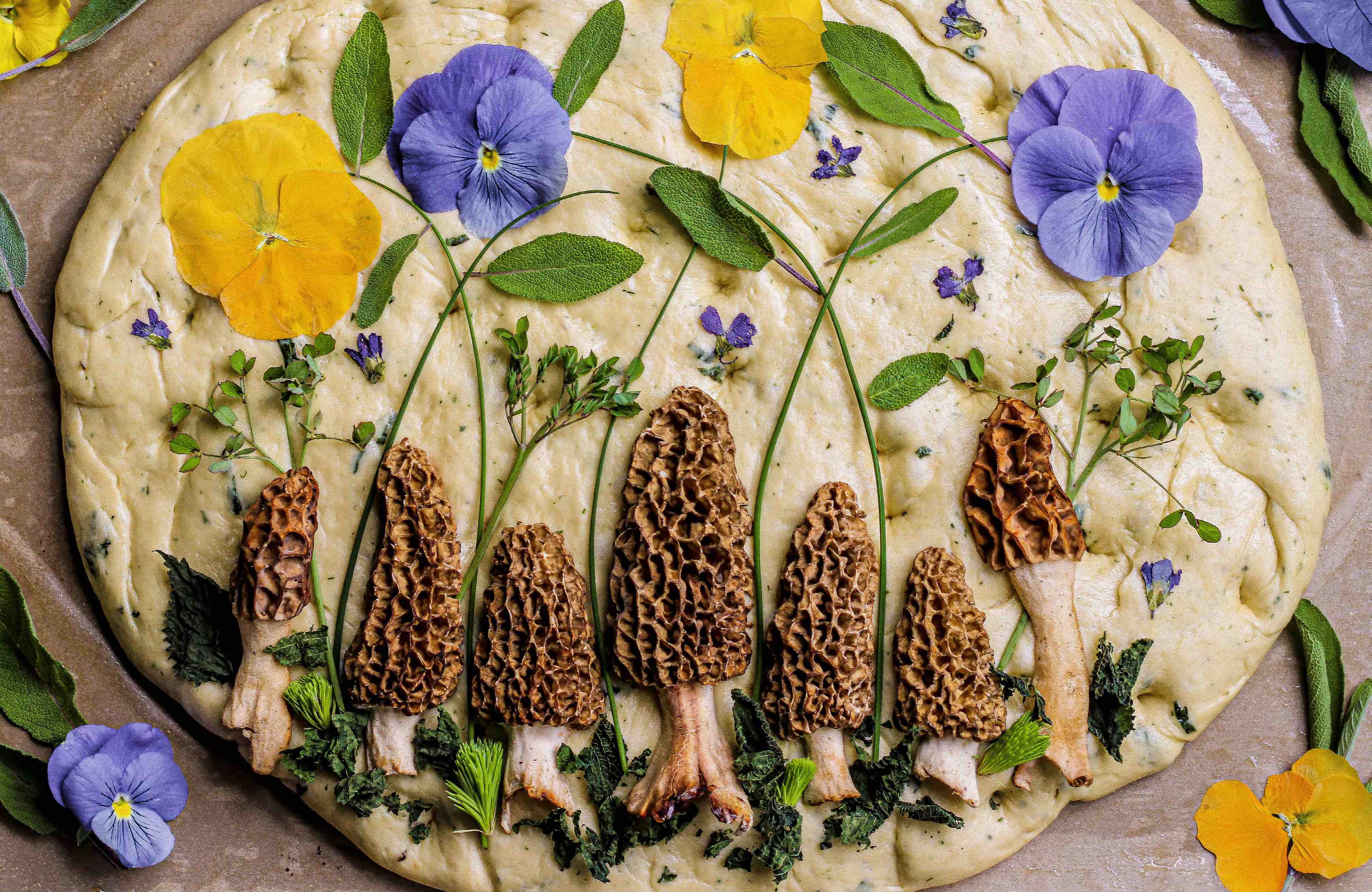
FORAGER’S FOCACCIA
by Must Love Herbs
2¼ teaspoons instant yeast
2 teaspoons sugar
1⅓ cups warm water
4 cups flour
2 teaspoons kosher salt (and more for topping)
½ cup olive oil (and more for greasing)
1 tablespoon dried dill (or 1½ tablespoons fresh)
¼ cup dried nettle (crumbled)
Desired toppings for decoration Directions: Combine the yeast, sugar, and warm water in a bowl. Stir gently and set aside. Allow the yeast to rest and become frothy (around 15 minutes). While the yeast is resting, begin on the flour mixture.
To your mixing bowl (stand mixer fitted with dough hook is preferred) add flour, salt, olive oil, dill, and nettle. Mix to incorporate ingredients. This should take around 30 seconds. While the mixer is still running, pour the yeast mixture in slowly. Once all yeast is evenly distributed, increase speed to medium. Allow to mix for 5 minutes. Turn the mixer off and scrape the sides and bottom of the bowl. Mix for another 5 minutes on medium. While the dough is mixing add olive oil to coat the bottom and sides of a large bowl. Turn the mixer off and form dough into a ball. Transfer the dough to your prepared bowl. Once in the bowl, turn the dough to evenly coat all sides. Cover and allow to rest in a warm spot for 60 to 90 minutes, or until doubled in size.
Preheat oven to 400ºF.
Grease the bottom of your preferred pan with olive oil. I used a half-sheet pan. Pour your dough out onto the center of the pan. Use your hands to gently spread the dough out to your desired shape. You may cover an entire pan for a thinner focaccia, make a medium-size oval as I did, or even use a casserole dish for a thicker version. Once you have achieved your desired shape, cover the dough again and allow to rest for 30 minutes.
Brush the top of your dough with olive oil evenly across the surface of the dough. Use your fingers to press down through the top of the focaccia until you feel the pan underneath. Now it’s time to decorate! I used foraged morels, wild chives, violets, and nettle from the forest around my home. I also used pea shoots, pansies, and sage from my garden. You can use a variety of mushrooms, peppers, tomatoes, herbs, edible flowers, onions, capers, etc.—the possibilities are endless. Sprinkle with kosher salt. Bake for 25 to 30 minutes or until golden brown and cooked through. Allow to cool slightly before serving. Enjoy!
Follow Lauren May on Instagram @mustloveherbs.
